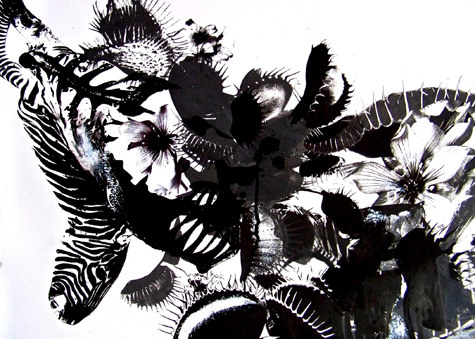
MINGLING, MIXING MEDIA Detail from “Zoo,” mixed-media, by Stacy Howe. |
Encompassing a broad range of themes, media, and levels of participation, each set of works in this year’s Maine College of Art exhibition by nine thesis-level Master’s of Fine Arts students achieves its own world and requires a separate toolkit to process and unpack.
The 16 pillars in the Congress Street window gallery belong to “Ten Miles Square,” Alexandra Silverthorne’s photographic investigation of the topographic origins and evolution of the Washington DC boundary. In an accompanying book of photographs laid accordion-style, Silverthorne exhaustively captures the present-day life seen from each of the 40 sandstone markers that have delineated DC since 1792. With each page offering four photographs taken from each marker, Silverthorne constructs a bioecological negative image of how the stones regard the capital, emphasizing quotidian existence over political boundary.
In the hallway, five oil paintings from Michel Droge’s “Requiem For the Lost” series make strong use of warm, damp color fields and Neo-Expressionist wraiths. An adjoining gallery contains the work of the exhibition’s most complementary artists, Stacy Howe and Alisha Gould. Howe’s mixed media works depict lurid, hallucinatory scenes that mingle the beautiful and horrible with a stray zebra limb or two; Gould’s sculptures obsessively investigate the lines separating the internal and external. Her white-portalled sculptures scale from tiny to enormous and appear as much like blanched daffodil trumpets as they do the interior tearings of gunshot wounds.
And then the fun begins — with the remaining five works, which all require some level of interaction or immersion. In “Nickel Mines Pennsylvania,” Bill Cifuni’s hauntingly serene videos of the area around a schoolhouse in Lancaster County, Pennsylvania, are projected simultaneously onto the four interior walls of a large tent. A stack of postcards at the rear door offers a brief and chilling exposition. Another video installation, Mari Skarp’s “Archaeology of the Memory Corridors (interior and exterior),” shows the interior and contents of a foreclosed home. A slow camera pan glosses over out-of-focus domestic items and furniture, familiar yet blurry and impossible to grasp. In a second Skarp video, a vague authority figure brusquely shovels a child’s toys from a bedroom carpet into a black trash-bag.
A favorable curator’s decision placed Skarp’s work near Ryan Conrad’s “Cruising the Cartography” installation, where three recursive audio interviews emanate from a labyrinthine structure of black cardboard. Watching Skarp’s silent, entropic video, it is impossible to tune out the sound of a young adult man’s occasionally harrowing confessional monologue on the hidden agenda behind cruising laws and the difficulty of sexual expression in public: “Most of my experiences with cruising has been online . . . my friends don’t know. That’s really scary. Something could go wrong. No one would know.”
Mounted near the concealed entrance, an enlarged newspaper article from a May 1996 issue of the Casco Bay Weekly walks us through Portland’s checkered political history of cruising laws and the homophobia they often conceal. Though light quickly recedes in the narrow corridors of Conrad’s building, many similar articles are posted on the walls. From dark dead-ends, a recording of a male voice speaks to the codified language and ritual of gay male sexuality, while two female professors elaborate on, among other things, a botched sting operation where former Portland police chief Mike Chitwood had invited the media to witness him shine spotlights into empty West End bushes. Like any good labyrinth, the surprise in the center of Conrad’s is worth the scramble.